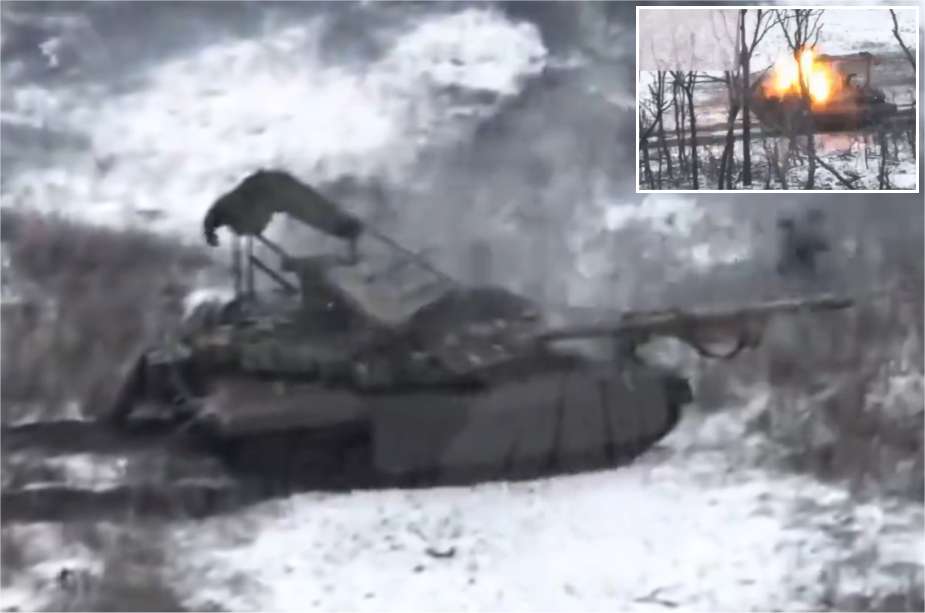- Army
- Conflicts in the world
- Israel - Iran conflict 2025
- Pakistan - India Conflict 2025
- Russia Ukraine War 2022
- Libya conflict day by day
- HAMAS - Israel War 2023
- Operation Serval in Mali French Army
- Sangaris operation Central African Republic
- Sangaris opération militaire République Centreafrique
- Ukraine - Russia conflict
- Syria conflict news
- Defence & Security Industry Technology
- Armies in the world
- Analysis Defense and Security Industry
- Conflicts in the world
- Navy
- Air
Ukrainian Soldiers Use FPV Drone Armed with RPG Rocket Warhead to Target Russian T-90M Tank
A Russian T-90M main battle tank has recently been neutralized in a drone strike. This event is intriguing for several reasons, particularly because of the nature of the armament used. A simple drone equipped with an RPG warhead was sufficient to neutralize the Russian tank, despite the presence of Explosive Reactive Armor (ERA). Subsequently, the crew abandoned the vehicle.
Follow Army Recognition on Google News at this link

A Russian T-90M main battle tank is touched by a Ukrainian UAV. (Picture source: Ukrainian MoD)
The T-90M tank, considered one of the most advanced in the Russian arsenal, is designed to withstand a wide range of attacks thanks to its Kontakt-5 ERA. This technology is specifically engineered to absorb and deflect the energy of anti-tank projectiles, significantly reducing their penetration capability. The effectiveness of this armor has been proven on numerous battlefields. Therefore, it is quite surprising to see an RPG-7 munition capable of neutralizing a vehicle equipped with protection specifically designed to counter such a threat.
The RPG-7, an anti-tank grenade launcher dating back to the Soviet era, is known for its simplicity and reliability, but not necessarily for its ability to penetrate sophisticated modern armor like that of the T-90M. The fact that such ammunition succeeded in disabling the tank highlights two critical points. First, even the most advanced military technologies can be vulnerable to ingenious tactics and seemingly obsolete weapons when used effectively. Second, there are legitimate questions about the reliability and real capabilities of Russian ERAs, which failed where they were supposed to excel.
It is also possible that this was simply an extraordinarily precise strike by the drone, targeting a less protected area or exploiting a structural weakness. In any case, the crew of the T-90M decided to abandon the vehicle, and the video does not confirm its destruction, capture, or even towing by another Russian unit.
Yet, the T-90M is one of the most sophisticated tanks in the Russian arsenal. This tank stands out for its powerful armament, its (normally) advanced protection, and operational capabilities, positioning it as a key player on modern battlefields.
It is equipped with a 125mm cannon, capable of firing a wide variety of munitions, including guided anti-tank projectiles. Additionally, it has a 7.62mm PKT coaxial machine gun and a 12.7mm NSVT machine gun.
With a maximum speed of 60 km/h, it is relatively fast for a tank of its weight, allowing it to maneuver effectively over different terrains. Its operational range is 550 km, providing good autonomy for extended missions.
Furthermore, the T-90M is equipped to handle difficult combat environments. It has an NBC (nuclear, biological, chemical) protection system, a fire detection and suppression system, a nose-mounted dozer blade for mobility over rough terrain, a deep fording kit, as well as a modern fire control system for increased accuracy. Its active protection system is a notable feature, enhancing its ability to counter incoming threats. With a crew of three people, the T-90M measures 6.68 meters in length, 3.78 meters in width, and 2.23 meters in height.
This event underscores the evolution of modern warfare, where asymmetric tactics and the integration of low-cost technologies, such as drones, can level the playing field against conventionally powerful military assets. It also raises questions about the effectiveness of Russian heavy armor in an era where innovative tactics and technologies are continuously emerging on the battlefield.
If you'd like to find out more about how this type of drone works, we recommend Chuck Pfarrer's excellent infographic, which you can find here.
 DJI First Person Video racing drone. (Picture source: Chuck Pfarrer)
DJI First Person Video racing drone. (Picture source: Chuck Pfarrer)


























